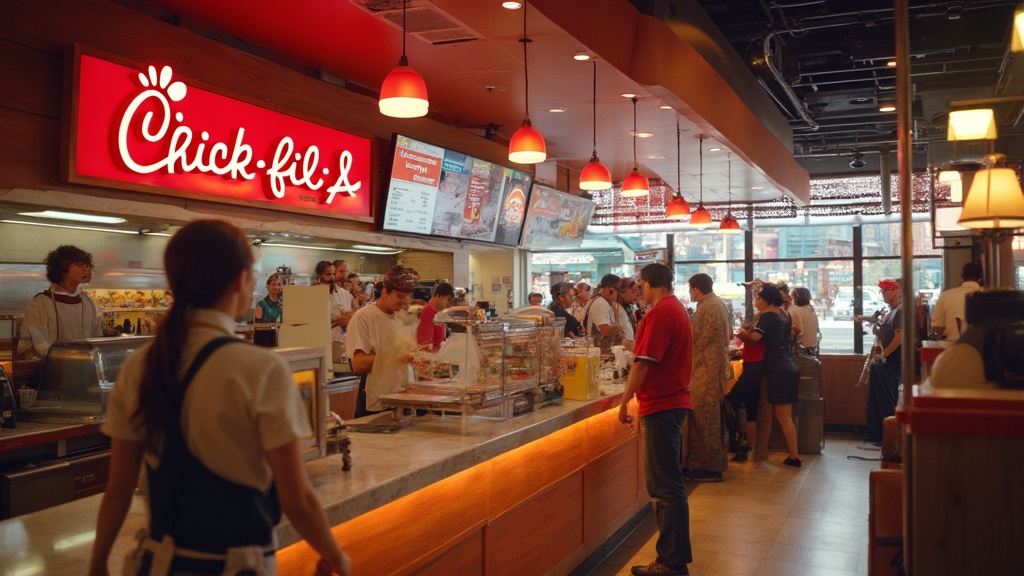Introduction
Navigating the world of franchising can be both exciting and daunting, especially when considering a brand as iconic as Chick-fil-A. With a reputation for exceptional customer service and a loyal customer base, potential franchisees are drawn to the opportunity of owning a piece of this successful enterprise. However, the financial landscape is complex, requiring a careful examination of:
- Initial investments
- Ongoing operational costs
- Potential earnings
From understanding the competitive acceptance rate to exploring strategies for maximizing profitability and managing financial risks, aspiring franchise owners must equip themselves with the right knowledge and tools. This article delves into the essential aspects of owning a Chick-fil-A franchise, offering insights that can guide prospective franchisees in making informed decisions that align with their business goals and aspirations.
Financial Overview: Costs and Earnings of a Chick-fil-A Franchise
The initial investment for a popular fast-food franchise is notably accessible compared to many other franchise opportunities, with initial franchise fees typically falling between $10,000 and $15,000. However, it’s crucial for potential business owners to account for additional expenses such as equipment, inventory, and property leases, which can escalate the total investment to anywhere from $300,000 to $2 million, largely influenced by location and operational size. It’s important to note that the fast-food chain only accepts 100 to 115 operators from the 40,000 who apply each year, resulting in a highly competitive acceptance rate of just 0.25 percent.
Moreover, franchisees do not own the business; the company retains ownership of the land, building, and equipment, operating more like a rental agreement. On the earnings front, the fast-food establishments are impressive performers, often generating average annual sales exceeding $4 million, with profit margins ranging from 7% to 8%. Understanding these financial figures is essential for assessing whether this business aligns with your financial objectives and long-term wealth-building aspirations.
As Eric Stites, Founder and CEO of Franchise Business Review, insightfully points out, ‘For many people, the choice of going into business is about building long-term wealth through equity… building a valuable asset that you can ultimately sell or pass on to your family.

Maximizing Profitability: Strategies for Chick-fil-A Franchisees
To enhance profitability in a franchise setting, especially for Chick-fil-A, those running the business should adopt a multifaceted approach that encompasses several essential strategies, as suggested in various Chick-fil-A franchise reviews:
-
Exceptional Customer Service:
Training staff to deliver outstanding service is pivotal. A staggering 73% of clients stay loyal to brands because of amiable service representatives, emphasizing the need for business owners to prioritize client interactions. Furthermore, Forrester emphasizes that clients prefer knowledge bases over all other self-service channels, highlighting the importance of providing accessible information to enhance user experience.
-
Community Engagement:
Actively participating in local events or sponsoring community activities fosters brand loyalty and strengthens community ties. This engagement not only enhances visibility but also cultivates trust within the community.
-
Menu Optimization:
Careful analysis of sales data can reveal popular menu items, enabling franchisees to introduce limited-time offerings that drive sales and keep the menu fresh and appealing.
-
Effective Marketing:
Utilizing the power of social media and local advertising enhances brand visibility and draws in new clients. Research suggests that almost 90% of consumers have faith in companies evaluated as ‘very good’ in service, indicating that focusing on these strategies can greatly strengthen a franchisee’s bottom line, as reflected in Chick-fil-A franchise reviews, while also improving satisfaction and loyalty. Additionally, it is crucial to address consumer frustrations; 28% of consumers find it frustrating when simple information is hard to find, which reinforces the necessity of clear communication and service efficiency.
Lastly, the case study titled ‘Taking Care of Your Support Team’ illustrates that prioritizing employee satisfaction can lead to improved service quality and client loyalty, ultimately benefiting the business financially.

Pros and Cons of Owning a Chick-fil-A Franchise
Owning a fast-food franchise presents a unique blend of advantages and challenges that aspiring entrepreneurs should consider. One of the key benefits is the strength of the brand, which enjoys remarkable customer loyalty and recognition in the fast-food industry. Franchisees receive extensive training programs that equip them with the necessary skills to succeed in a competitive market.
Financially, the investment ranges from $2,295 to $23,465, with a cash requirement of $10,995, which is an important consideration for potential owners. However, they should also be aware of notable challenges, such as:
- Limited menu flexibility
- The requirement to remain closed on Sundays, a decision rooted in the company’s conservative values
This operational model may not resonate with everyone’s entrepreneurial aspirations.
Furthermore, it is important to note that the restaurant operators do not own the business assets; the company retains ownership of the land, building, and equipment, which are leased to independent operators. As noted by industry expert Russ O’Rear:
In a world obsessed with food trucks and mobile food and beverage concepts, finding the right balance of opportunity and sustainability can be the perfect recipe for success.
Therefore, weighing these advantages against the restrictions imposed by the company’s strict operational guidelines is crucial for prospective franchisees.
Case studies, such as the experiences of Skyler Walker and Jon Dietzen with the Travelin’ Tom’s Coffee establishment, illustrate the potential rewards and experiences that can come from ownership. Comprehending these dynamics can assist individuals in deciding if owning a franchise aligns with their personal and professional goals.

Operational Support and Training for Franchise Success
Chick-fil-A takes pride in offering comprehensive operational support and a robust training program for its operators, as noted in various Chick-fil-A franchise reviews, which highlight an intensive multi-week training course. This program is meticulously designed to cover key aspects of restaurant operations, leadership development, and customer service, ensuring that operators have a well-rounded foundation. Moreover, ongoing support is facilitated through regional consultants who offer tailored guidance, as well as a dedicated network of franchisee peers that fosters collaboration and knowledge sharing.
This structured support system not only equips new owners with the essential skills and insights needed to manage their business effectively, as highlighted in Chick-fil-A franchise reviews, but also significantly enhances their chances of success in a competitive market. With an initial franchise fee of $10,000, potential franchisees gain access to this extensive support. Andrew Cathy, CEO, emphasizes that “the company wants to continue to dip its toes in international markets and learn from these experiences,” highlighting the organization’s commitment to growth and adaptability.
The case study of the fast food chain’s international market testing illustrates this learning process, demonstrating how the company has adapted its strategy following past experiences, which is crucial for sustaining the brand’s high standards and client satisfaction.

Navigating Financial Risks: Strategies for Chick-fil-A Franchisees
To effectively manage financial risks as a Chick-fil-A franchisee, it is essential to implement a structured approach, as highlighted in various Chick-fil-A franchise reviews. Here are four strategies to consider:
-
Thorough Financial Planning: Developing detailed budgets and forecasts is crucial for anticipating cash flow needs.
This proactive measure allows you to prepare for fluctuations in revenue and ensures your business remains viable during challenging periods. As noted in the context of nearly 5 million Hispanic-owned businesses, effective financial management is vital for success and sustainability.
-
Insurance Coverage: Securing the right insurance policies safeguards your investment against unforeseen events.
Adequate coverage helps mitigate risks associated with liability, property damage, and other potential disruptions, providing peace of mind as you operate your franchise.
-
Diversification of Revenue Streams: Expanding your offerings—such as introducing catering services or enhancing delivery options—can significantly boost your customer base and sales.
This strategy not only increases revenue but also builds resilience against market changes.
-
Regular Financial Review: Consistently monitoring your financial performance is vital.
Conducting periodic reviews allows you to adjust strategies based on current data, ensuring that your business remains competitive and profitable. As highlighted in the case study on managing small business finances, collaborating with financial advisors can help navigate complexities and optimize strategies for long-term growth, ultimately leading to positive Chick-fil-A franchise reviews. Incorporating these strategies into your operational framework can significantly reduce financial risks, promoting long-term stability and success in your franchise journey.
Additionally, utilizing the F.O.R.M. framework—Family, Occupation, Recreation, Money—can guide your financial planning efforts.
Collaborating with tax professionals and financial advisors will provide insights into tax-saving opportunities and further enhance your profitability.

Conclusion
Owning a Chick-fil-A franchise offers a unique opportunity characterized by a strong brand presence and a loyal customer base. The initial investment is relatively accessible compared to other franchises, yet prospective franchisees must remain vigilant about ongoing costs and the competitive nature of the application process. With a mere 0.25% acceptance rate, understanding the financial landscape—including initial fees, potential earnings, and operational costs—is essential for aligning this venture with personal financial goals.
Maximizing profitability hinges on effective strategies such as:
- Delivering exceptional customer service
- Engaging with the community
- Optimizing the menu
- Employing targeted marketing efforts
These approaches not only enhance customer loyalty but also contribute to the overall success of the franchise. Moreover, recognizing the balance between the benefits of brand strength and the challenges of operational restrictions is crucial for any aspiring franchisee.
Chick-fil-A’s commitment to training and operational support further empowers franchisees, equipping them with the necessary skills to navigate the competitive market effectively. By implementing sound financial practices, including:
- Thorough planning
- Adequate insurance
- Diversification of revenue streams
franchise owners can mitigate risks and foster long-term success.
In conclusion, the journey of owning a Chick-fil-A franchise is one that requires careful consideration and strategic planning. With the right knowledge and resources, aspiring franchisees can not only thrive in this environment but also contribute positively to their communities while building a sustainable business. Taking the time to weigh the pros and cons, alongside a commitment to continuous learning and adaptation, will ultimately pave the way for a rewarding franchise experience.


